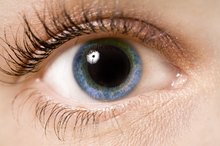Side Effects of Dilating Eyes
Dilating drops allow doctors a better view into the eye, make it easier to perform eye surgery, and relieve the pain of some eye diseases, like uveitis, an inflammation of the uvea in the eye. Drops used to dilate eyes are called mydriatics. Cycloplegic drops are a type of mydriatic drop; cycloplegics paralyze the ciliary muscles to keep the pupil dilated. Some dilating drops combine mydriatics and cycloplegics. Like any medication, dilating drops can cause side effects. Side effects of cycloplegics are longer lasting and potentially more serious.
If you are experiencing serious medical symptoms, seek emergency treatment immediately.
Mydriatic Effects
Dilating drops can sting and burn when first inserted. This effect normally lasts only a minute or two, according to the Mayo Clinic 12. Eye irritation or reddening may occur. Drops that are strictly mydriatics, with no cycloplegic drug added, like phenylephrine, dilate the eye for several hours 2. The side effects of pupil dilation are light sensitivity and blurred vision. Headache and pain in the brow can also occur, according to the Mayo Clinic 12.
Cycloplegic Effects
Alphabetic List of Eye Drops for Glaucoma
Learn More
Cycloplegic drugs paralyze the ciliary muscles of the eye and keep the pupil open longer. Atropine, a cycloplegic, is a drug that has long lasting effects; if atropine is given, the pupil may stay dilated for two weeks, according to the Mayo Clinic 12. Eyes may water or redden from cycloplegic drops, also according to Mayo, and eyelids may swell. Cycloplegics can cause:
- a serious rise in intra-ocular pressure in people with narrow angle glaucoma
- which is fluid buildup behind the colored part of the eye
- the iris
- according to Aging Eye Times,
- should not be given to people with this condition
Cycloplegics also cause a loss of accommodation in the eye; accommodation is the changing of the curvature of the lens to see objects close up.
- Cycloplegic drugs paralyze the ciliary muscles of the eye and keep the pupil open longer.
- Cycloplegics can cause: * a serious rise in intra-ocular pressure in people with narrow angle glaucoma
* which is fluid buildup behind the colored part of the eye
* the iris
* according to Aging Eye Times,
* should not be given to people with this condition Cycloplegics also cause a loss of accommodation in the eye; accommodation is the changing of the curvature of the lens to see objects close up.
Systemic Effects
Any dilating drop can be absorbed systemically and cause side effects outside the eye. Thirst, dry mouth or skin, or unusual tiredness may also occur.
Related Articles
References
- Mayo Clinic; Atropine
- Mayo Clinic; Phenylephrine
- Aging Eye Times; Phenylephrine Hydrochloride Ophthalmic
- Chia A, Chua WH, Cheung YB, et al. Atropine for the treatment of childhood myopia: safety and efficacy of 0.5%, 0.1%, and 0.01% doses (Atropine for the Treatment of Myopia 2). Ophthalmology. 2012;119(2):347-54. doi: 10.1016/j.ophtha.2011.07.031
- Kaymak H, Fricke A, Mauritz Y, et al. Short-term effects of low-concentration atropine eye drops on pupil size and accommodation in young adult subjects. Graefes Arch Clin Exp Ophthalmol. 2018;256(11):2211-2217. doi:10.1007/s00417-018-4112-8
Writer Bio
A registered nurse with more than 25 years of experience in oncology, labor/delivery, neonatal intensive care, infertility and ophthalmology, Sharon Perkins has also coauthored and edited numerous health books for the Wiley "Dummies" series. Perkins also has extensive experience working in home health with medically fragile pediatric patients.









